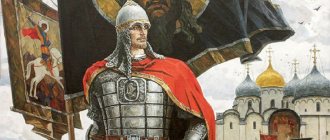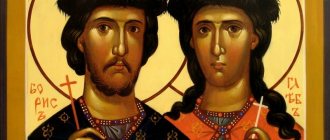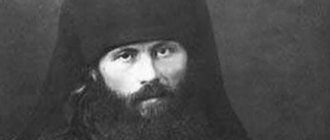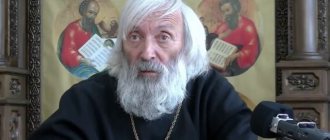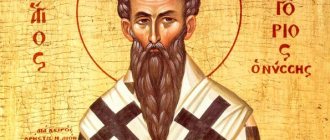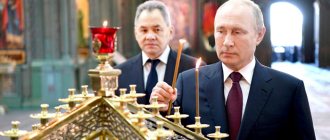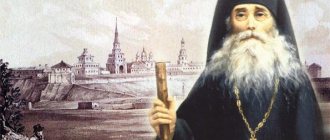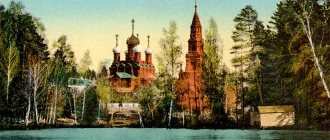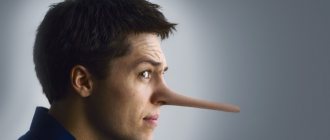Updated: 02/13/2020
Russian icon painting is a separate, primordial art direction, where the spiritual principle is organically intertwined with high artistic value. Many creations are masterpieces, where the lightest stroke is permeated with inner light and deepest meaning. We should thank for this the “cohort” of talented Russian icon painters, each of whom, starting with Andrei Rublev and ending with Simon Ushakov, contributed to the development of this trend. Many icon painters have remained anonymous, but their legacy is carefully preserved and passed on from generation to generation.
If we take the period of the 16th-18th centuries, then it can be called very fruitful. This is the heyday of icon painting, which gave the world many famous icon painters, whose creations we still admire today. It was at this time that the boundaries between the work of icon painters and painters were blurred - the former began to perceive and use in icons techniques and techniques borrowed from foreign artists. In many cases, icons are brought closer to life; the once familiar canons are no longer so obligatory. These changes are gradual, the clergy is still strongly opposed to new trends, but they are persistently advancing. The leading role in this was played by the figure of Simon Ushakov.
The biography of Andrei Rublev is mysterious
The great ancient Russian icon painter left little information about himself. For example, there is still debate about where he was born.
Some researchers believe that this is Veliky Novgorod. The generally accepted version says that this happened in the Moscow Principality.
Andrei Rublev paints the Spassky Cathedral. 15th century The biography of Andrei Rublev is unreliable and mysterious. All images of him are symbolic and do not claim to be authentic.
Rublev's date of birth is also disputed, so it is usually reported that he was born in the late 1340s. The monk's parents are unknown.
Since he had the nickname "Rublev", which means "rubel" or a tool designed for rolling leather, it is believed that he may have come from a family of artisans.
One of the icons attributed to Rublev has the inscription: “Andrei Ivanov son of Rublev.” From this fact, some art historians conclude that his father's name was Ivan.
The nickname "Rublev" means ruble - a tool for rolling leather.
Opponents of this version claim that the inscription is fake, since the icons of Rublev’s authorship began to be highly valued only after the restoration in 1904 of the main shrine of the Trinity-Sergius Lavra, the icon of the Holy Trinity.
Such inscriptions cannot be trusted, but they must be taken into account.
Sergius of Radonezh and Andrei Rublev, Ilya Glazunov. 1992 Andrei Rublev was a novice of St. Nikon of Radonezh
In addition, there is also a version that Andrei was born in the city of Radonezh, which is located near the Lavra. The fact that he later became a monk in the Lavra speaks in her favor.
In addition, in the life of Sergius of Radonezh, which was compiled by his student Epiphanius, Rublev is mentioned three times.
This speaks in favor of the version that he knew the saint. Scientists claim that the icon painter was a novice of St. Nikon of Radonezh.
Then he became a monk in the Spaso-Andronikov Monastery in Moscow. His first name is not known, although it may coincide with the monastic name.
Icon painting from the times of the Tatar-Mongol yoke
The invasion of Rus' by Batu Khan, which marked the beginning of the period of the Tatar-Mongol yoke, radically influenced the way of life of the state. Russian icon painting did not escape his influence. Most of the previously formed artistic centers were captured and ruined by the Horde, and those who passed the common fate experienced difficult times, which could not but affect the general artistic level of the works created in them.
Nevertheless, even during this difficult period, Russian icon painters managed to create their own school of painting, which took its rightful place in the history of world culture. The second half of the 14th century and almost the entire 15th century were marked by its special rise. During this period, a whole galaxy of outstanding masters worked in Rus', the most famous representative of which was Andrei Rublev, born in the Moscow principality around 1360.
During the Battle of Kulikovo, Andrei Rublev was a member of the princely artel of craftsmen
Indirect information from various sources suggests that the future famous icon painter was already a member of the princely artel of masters during the Battle of Kulikovo in 1380.
This artel was engaged in the construction and decoration of temples and monasteries. She did not live constantly in one place, but moved from city to city.
Annunciation Cathedral of the Moscow Kremlin. Andrey Rublev. Icon "Transfiguration", 15th century. The first mention of Andrei Rublev in the Russian chronicle dates back to 1405
Unfortunately, ancient Russian artists did not sign or date their icons. Therefore, Rublev’s life path can be traced only from the meager information preserved in the chronicles. However, such information contradicts each other.
The first time the name of Andrei Rublev appeared in the chronicle was in 1405.
The name of Andrei Rublev appears for the first time in the chronicle in 1405. The record says that he participated in the painting of the Annunciation Cathedral in the Moscow Kremlin together with Theophan the Greek and Prokhor the Elder.
At the same time, Andrei is called a Chernets in the text of the chronicle. Researchers claim that at this time the icon painter painted one of his best icons, the Transfiguration.
Apostle John the Theologian with his disciple Prokhor. Andrey Rublev (?), Khitrovo Gospel, 1392
His work on such a monument of Russian book art as the “Gospel of Khitrovo” dates back to the same time. Scientists claim that the initial letters and miniatures of the gospel belong to the pen of the monk.
It is believed that the customer of the masterpiece could have been either the Grand Duke or the Metropolitan himself.
The customer of the “Gospel of Khitrovo” could have been the Moscow Metropolitan himself.
The second time the chronicle speaks of Rublev is in 1408. Then the saint was sent to paint the Assumption Cathedral in Vladimir. Andrey did the painting together with master Daniil Cherny.
Icon painters, at the behest of Grand Duke Vasily Dmitrievich, carried out work to replace the lost parts of the cathedral frescoes.
Andrei Rublev was engaged in the restoration of a fragment of the grandiose fresco “The Last Judgment”, which occupied the western wall of the temple.
The work of Feodor Zubov
And finally, when talking about icon painting of the 17th century, one cannot fail to mention the name of another outstanding master - Feodor Zubov (1646-1689). Born in Smolensk, in the early 1650s, while still a teenager, he moved to Veliky Ustyug, where he painted the icon “The Savior Not Made by Hands” for one of the churches, which immediately created his reputation as a mature artist.
Over time, his fame spread so widely throughout Russia that the artist was summoned to Moscow and enrolled in the staff of icon painters at the Armory Chamber, where he then served for more than forty years. After the death of Simon Ushakov, who for many years headed the masters gathered there, Feodor Zubov took his place. Among the master’s other works, the “Apostolic Ministry” icon, a photo of which concludes the article, became especially famous. Zubov’s sons, Ivan and Alexey, also made a worthy contribution to the development of Russian art, who became one of the best Russian engravers in the Peter the Great era.
There is a museum of Andrei Rublev in Moscow
The third mention of the saint in chronicles dates back to the 1420s. Then Andrei Rublev worked on the paintings of the Trinity Cathedral of the Trinity-Sergius Monastery and restored its iconostasis. A few years earlier, the monastery was burned by the Tatars, who, having failed to take Moscow, attacked Vladimir.
While working in the monastery, the monk created his masterpiece, “The Holy Trinity.” This is the only reliably known icon painting by Rublev. This happened in the period from 1425 to 1427.
"Trinity", icon. Andrey Rublev. 1411 or 1425 - 1427. While working at the Trinity-Sergius Lavra, Andrei Rublev created his most famous masterpiece, “Trinity”
After the work in the monastery was completed, Denmark Black, who had been Andrei’s partner for many years, died.
After his death, the saint returned to the Andronikov Monastery and in the spring of 1428 he completed his last work. Epiphanius the Wise in his chronicle says that the icon painter took part in the construction of the Church of the Savior in the monastery.
January 29, 1430
on this day the venerable Andrei Rublev died
The Monk Andrei Rublev rested on January 29, 1430, during a pestilence (cholera). He was buried next to the bell tower of the Andronikov Monastery (Spassky Cathedral).
In 1993, archaeological excavations were carried out on the territory of the monastery. During their course, archaeologists discovered the throne of the cathedral and relics of unknown origin. A number of researchers attributed them to Rublev.
Currently, the Andrei Rublev Museum of Ancient Russian Art is located on this site.
A memorial sign was erected in memory of the Venerable Andrei Rublev, the great Russian icon painter buried in the Spaso-Andronikov Monastery
The name of the icon painter Andrei has always been revered among believers. That is why in 1988, in honor of the thousandth anniversary of the baptism of Rus', the Russian Orthodox Church canonized him. Rublev became the first in the history of the Christian Church to be canonized by it.
Outstanding master of fresco painting
The second half of the 17th century was marked by the work of another outstanding master - Gury Nikitin. Born in Kostroma, presumably in the early 1620s, he studied painting from a young age. However, the novice master gained serious experience in Moscow, where in 1653, together with an artel of his fellow countrymen, he painted a number of churches in the capital.
Guriy Nikitin, whose work became more and more perfect every year, became known primarily as a master of fresco painting. Many paintings made in monasteries and individual churches in Moscow, Yaroslavl, Kostroma, Pereslavl-Zalessky and Suzdal have survived to this day.
A characteristic feature of the frescoes painted by the master on biblical subjects is their festive color scheme and richness of symbolism, for which during his lifetime the artist was often reproached for secularizing art, that is, reorienting it towards the problems of the perishable world. In addition, the result of his creative search was a special artistic technique that allowed the master to create an extraordinary spatial effect in his compositions. It entered the history of art under the name “Guriy Nikitin’s formulas.” The famous icon painter died in 1691.
Andrei Rublev's teacher was Feofan the Greek
Chronicles say that Andrei Rublev worked with such masters as Prokhor the Elder and Daniil Cherny, who was his partner on his travels. However, Andrei Rublev’s teacher is Feofan the Greek.
It was from him that the icon painter acquired the skills of Byzantine writing and with his help became acquainted with Byzantine visual culture.
Feofan the Greek and Semyon Cherny painting the Church of the Nativity (miniature of the Front Chronicle, 16th century). Theophanes the Greek arrived in Rus' from Byzantium
The greatest Byzantine and Old Russian icon painter, master of fresco paintings and miniatures, Theophanes the Greek was born in 1340 and died in 1410. He was born in Byzantium. That is why he received the nickname “Greek” in Rus'.
Before the invitation to Rus', he lived and worked in Constantinople and other Byzantine cities. Immediately before his arrival, he lived for a long time in the Cafe. This is now Crimean Feodosia. Historians claim that he came to Rus' together with Metropolitan Cyprian.
Initially he settled in Novgorod. This happened in 1370. Here he painted the Church of the Transfiguration on Ilyin Street. Feofan had a huge influence on the development of all art of Veliky Novgorod. This applies to both fresco painting and icon painting.
Further information about the activities of Theophanes the Greek is vague. According to some reports, he continued his work in Nizhny Novgorod, and also visited Kolomna and Serpukhov. At the beginning of 1390 he arrived in Moscow. Here he painted temples, private houses, painted icons and miniatures for books.
Video: Icon painting school: Theophanes the Greek, Rublev, Dionysius. At 3.20 minutes, the author says that Andrei Rublev, unlike Theophan the Greek and other icon painters, paints an icon as a prayer, as a contemplation of the beauty of God.
Andrei Rublev, together with Theophan the Greek, worked in 1405 on the painting of the Annunciation Cathedral in the Moscow Kremlin.
1405
this year Rublev is working on the painting of the Annunciation Cathedral of the Moscow Kremlin
This period of his life dates back to his acquaintance with the Byzantine icon painter and training with him.
Art historians point out that Feofan introduced Andrei to the Byzantine tradition in the fine arts. Working with him, the monk honed his writing technique.
This seriously affected the formation of Rublev’s style, which began to approach canonical Byzantine writing.
Subsequently, the monk worked independently or in collaboration with Russian masters. He developed his own artistic style, which absorbed the best examples of Byzantine art, but did not copy it.
He is characterized by calmness and tranquility. In addition, all of Rublev’s works are distinguished by an ideal harmony of color, proportion and beauty.
Iconography of the pre-Mongol period
It is known that, along with Orthodoxy, Rus' borrowed from Byzantium the achievements of its culture, which received their further development in the Principality of Kiev. If the painting of the first Tithe Church erected in Kyiv was carried out by overseas masters invited by Prince Vladimir, then very soon Russian icon painters appeared in Pereyaslavl, Chernigov, Smolensk and in the capital itself, called the Mother of Russian Cities. It is quite difficult to distinguish their works from the icons painted by Byzantine teachers, since in the pre-Mongol period the identity of the national school had not yet been fully established.
Very few works made during that period have survived to this day, but even among them there are genuine masterpieces. The most striking of them is the double-sided Novgorod icon “The Savior Not Made by Hands,” painted by an unknown master at the end of the 12th century, on the back of which the scene “Adoration of the Cross” is depicted. For more than eight centuries, it has amazed the viewer with the accuracy of the design and its smooth modeling. Currently, the icon is in the collection of the State Tretyakov Gallery. A photo of this icon opens the article.
Another, no less famous work of the pre-Mongol period, exhibited in the State Russian Museum of St. Petersburg, is also the Novgorod icon, known as the “Golden Haired Angel”. The angel's face, full of subtle emotionality and deep lyricism, gives the viewer the impression of calm and clarity. Russian icon painters completely inherited the ability to convey such feelings from their Byzantine teachers.
Many works attributed to Rublev do not belong to him
The “discovery” of Andrei Rublev occurred in the 19th century, when the growth of Russian national consciousness began in the run-up to the First World War. At the same time, since little information about the icon painter has been preserved, many of the works attributed to him turned out to be fake or not by him.
This is also due to the fact that Rublev’s icons were recognized by the Russian Orthodox Church as standard icons and therefore were copied in large quantities. The Apostle Paul and Archangel Michael were especially often depicted “like Rublev.”
Video: Levon Nersesyan about Andrei Rublev. In the first minute, the author says that the only work that belongs 100% to Andrei Rublev is the Trinity icon, since there are mentions of it in handwritten sources.
Art historians have found that today there are only seven works of art of which it is reliably known that their author was Andrei Rublev. These are both frescoes and icons. Another 15 works are controversial, but still, based on the manner of writing, they are classified as Rublev’s.
In addition, there are many different copies and imitations. In our time, icon photographs of Andrei Rublev are often sold as souvenirs in cultural and religious centers of the country.
Today there are 7 works for which the authorship of Andrei Rublev has been reliably established.
Art historians most often talk about the icons “Trinity”, “Savior Not Made by Hands”, “Annunciation”, “Our Lady of Vladimir”, “Transfiguration of the Lord”. This is an example of the “Rublev style”.
Many modern icon painters, reviving the traditions of Russian icon painting, lost during the Soviet period, take these works of St. Andrew as a model.
A worthy successor to the masters of the past
The successor of the artistic traditions laid down by Andrei Rublev and his contemporaries was Dionysius, an icon painter whose icons, made for the cathedral church of the Assumption of the Blessed Virgin Mary of the Joseph-Volokolamsk Monastery, as well as the frescoes and iconostasis of the Ferapontov Monastery, forever entered the treasury of Russian culture.
It is known that Dionysius, unlike most Russian icon painters, was not a monk. He carried out most of the orders together with his sons Vladimir and Feodosius. Quite a lot of works made either by the artist himself or by the artel he led have survived to this day. The most famous of them are the icons - “The Baptism of the Lord”, “The Mother of God Hodegetria” (next photo), “The Descent into Hell”, as well as a number of other works.
The years of his life are not precisely established, it is only known that the master was born around 1444, and the date of death is approximately 1502-1508. But his contribution not only to Russian but also to world culture is so great that by decision of UNESCO 2002 was declared the Year of Dionysius.
There is a museum of Andrei Rublev in Moscow
The works of the outstanding ancient Russian icon painter are kept in many museums and private collections. For example, in the Tretyakov Gallery an entire room is dedicated to Rublev.
The famous Savior of Andrei Rublev is exhibited here. Photos of icons are included in many textbooks, art history collections, as well as scientific literature.
Andrei Rublev Museum in the Spaso-Andronikov Monastery. Exposition of ancient Russian icons
In Moscow, on the territory of the former Spaso-Andronikov Monastery, the Central Museum of Ancient Russian Culture and Art named after Andrei Rublev has been operating since 1947.
The goal of its activities is the preservation of ancient Russian cultural heritage. First of all, this is the preservation of ancient Russian icons.
XVI
in this century the first icons of Andrei Rublev appeared
Unfortunately, no material evidence, other than his works, about the life of Andrei Rublev has been preserved.
That is why modern young people who want to see a “photo of an icon painter” can turn to the icon of the saint. Its first icons appeared in the 16th century.
Rev. Andrei Rublev (circa 1360 - October 17, 1428). Church of the Holy New Martyrs and Confessors of Russia in Brooklyn
The days of veneration of the saint are June 26 and July 17. Copies of the icon of the saint are kept in the Trinity-Sergius Lavra and the Spaso-Adronikov Monastery in Moscow.
It is also worth noting that many creative people dedicated their works to the image of Andrei Rublev. For example, Andrei Tarkovsky shot a film of the same name in 1966, which became a masterpiece of world cinema.
Prayer to St. Andrei Rublev
Nowadays, people pray to the saint for the discovery of talent and help in work.
O sacred head, reverend father, most blessed Abbot Andrew! Do not forget your poor to the end, but always remember us in holy and auspicious prayers to God:
remember your flock, which you yourself shepherded, and do not forget to visit your children, pray for us, holy father, for your spiritual children, for you have boldness towards the Heavenly King:
do not keep silent to the Lord for us, and do not despise us, who honor you with faith and love: remember us unworthy at the Throne of the Almighty, and do not stop praying for us to Christ God,
for grace was given to you to pray for us.
We do not imagine that you are dead: even though you have passed away from us in body, but remain alive even after death, do not depart from us in spirit,
keeping us from the arrows of the enemy and all the charms of the devil and the snares of the devil, our good shepherd.
Even though your relics are always visible before our eyes, your holy soul is with the angelic hosts, with disembodied faces,
with the heavenly powers, who stand at the throne of the Almighty, rejoice worthily, knowing that you are truly alive after death,
We bow down to you and pray to you: pray for us to Almighty God, for the benefit of our souls, and ask us time for repentance,
may we pass from earth to heaven without restraint, may we be delivered from bitter ordeals, demons of the princes of the air, and from eternal torment,
and may we be heirs of the Heavenly Kingdom with all the righteous who have pleased our Lord Jesus Christ from all eternity:
To Him belongs all glory, honor and worship, with His Father without beginning,
and with His Most Holy and Good and Life-giving Spirit,
now and ever, and unto ages of ages. Amen.
By leaving a comment, you accept the user agreement
